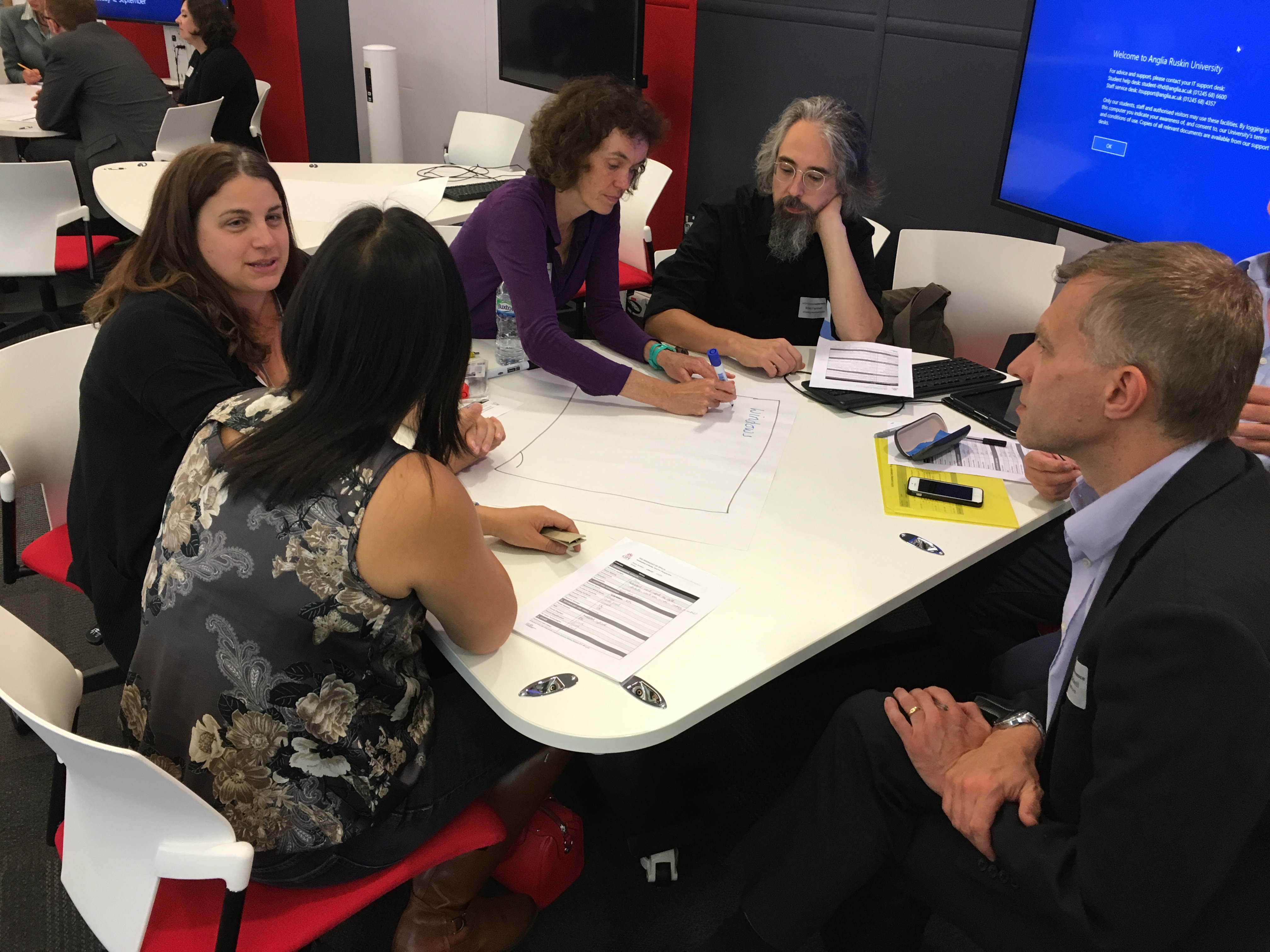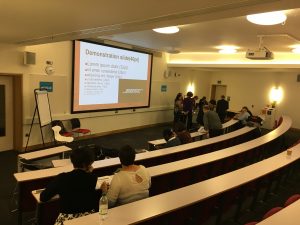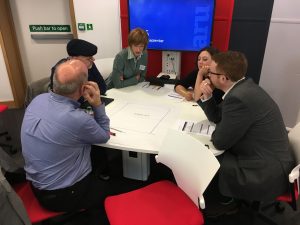Contents
- Following the success of our workshop on The Pedagogy of Space, Dom Pates and I were invited to present at Anglia Ruskin’s Active Learning Conference
- The following is a report from the rest of the conference.
- Sharon Waller chair & Head of Learning & Teaching at ARU, introduced the keynote speaker, Professor Mike Sharples from the Open University
- The title was ‘Designs for Active Learning’
- Session 1 – papers x 3
- “So many ideas on how to use this space! Creating spaces for active learning”. London School of Economics team
- Session 1.2.
- Trisha and Rachel from Sheffield Faculty of Engineering
- Session 1.3
- Flipped, authentic and problem based labs, Swansea University
- ALC Panel Q&A chaired by Mike Sharples.
- What are the main challenges of Active Learning?
- Recommendations for other institutions?
- Afternoon session.
Following the success of our workshop on The Pedagogy of Space, Dom Pates and I were invited to present at Anglia Ruskin’s Active Learning Conference
It was very successful with an encouraging level of engagement from delegates, shown below engaged with our two activities.
The first activity was to evaluate two learning spaces whist adopting the personas of a learner as well as an academic. The second group activity was to deconstruct a learning space, delegates have to leave their comfort zone somewhat but it is quite an eye opener in how people are freed from conventional approaches to consider how learning can be experienced in a more fundamental way.
The following is a report from the rest of the conference.
Sharon Waller chair & Head of Learning & Teaching at ARU, introduced the keynote speaker, Professor Mike Sharples from the Open University
The title was ‘Designs for Active Learning’
Mike quoted from Pew Research Centre prediction from 2012, a distance learning expert forum “By 2020 HE will be quite different from the way it is today.” With a combination of campus and online learning. Why? We need learning for the future, with a loss of recognised jobs, with many unknown jobs changing rapidly, Mike referred to https://careers2030.cst.org/jobs/
He believes that we need students to have transferable skills, especially pertinent in ref. to ‘Learning for a Changing World’, oecd. By 2020 – 204 million students work wide, 29% from China, Also the New Science of Learning paper on “Foundations for a new science of learning” Meltzoff, Kuhl, movellan, & Sejnowski. Mike stated that we also need to promote evidence based education, and referred to ‘Learning the Smart Way’ by P. Kirschner and M Neelan 2015.
The Annual Report, ‘Innovating Pedagogy’ is a main part of the Open University’s research contribution. Mike talked us through the following sections of note; under “Theory and practice of teaching, learning and assessment”
New pedagogies, Mike discussed the following 5 areas;
- Explore first,
Flipped classroom, in own time learn from text and video then in class work in groups with teacher to solve problems and explore misunderstandings
- Active learning
Why not flip this with group exploration first then video lecture? Schneider Blikstein 2016, flipping the flipped classroom, IEEE Transactions on learning technologies
Potential learning gains
2. Spaced learning.
Kelley and Watson 2013, making long term memories in minutes, Frontiers in human neuroscience, provided evidence from neuroscientist about value of spaced learning. With active breaks between presentation, students then recall key concepts and then students apply knowledge. Exciting opportunity for new learning.
3. Conversational learning group work. A big success story over the past 40 years, people learn better when they learn better in certain conditions, need shared goals, each person knows how to contribute and when, everyone makes an appropriate contribution
Future learn. On line learning from OU private company based on idea of MOOCs, developed their own platform, now with 6 million registered users,
The more people who exchange ideas and perspectives the better the learning experience. Each piece of content linked to discussion forums, proved very successful against expectations Social networked learning, used filters, following, no anonymity, moderating, roles, peer facilitating
4. Learning design and analytics
Intended mix of activity. Learning design had an impact on student satisfaction. He discussed Predictive analytics, OU Analyse.
Data. Analyse. Outcome.
Prediction of student outcomes based on performance early in the course, with opportunities to feed back to students themselves and present analytics for personalised learning with activity recommender
5. Changing higher education.
- Enhanced education
- New education
- Sustainable education
Mike referred to Blended Learning US Dept of Education 2009, B Means et al. A meta study of comparisons online learning v face to face.
As well as a notable example from Edinburgh Uni. Moray House School of Education.
Mike’s vision of the future is for more blended and hybrid courses with moocs and modules, with professional development support for new careers, a more flexible model of provision. Including affordable education, pay for use model, that is disaggregated.
Session 1 – papers x 3
“So many ideas on how to use this space! Creating spaces for active learning”. London School of Economics team
They carried out a 2 year evaluation and spoke to 440 students, 180 videos, one key observation is that students created their own active learning experiences!
- Parish Hall, something of a toe in the water, looking at the built pedagogy
Encouraging mixed teaching methods, to promote active learning and lectures. Many challenges; not involved in the beginning as stakeholders, timetable issues for teachers not being in the right spaces, access to power didn’t happen, room temperature, maintenance issues, carried out full evaluation, decor made a difference.
2. Clement House, transition of informal spaces,
LSE aiming to change form of assessment currently exams, not enough space for group work and informal learning. Thought about subtle aspects with respect of artwork in spaces, environmental features. Evaluation found students largely working individually as curriculum. Students found their own way of using spaces.
3. 20 Kingsway, based on previous projects looking at low quality classroom and applying new design process to engage with academics, led to new ideas about how to use space and work with architects. Aim to create experiences with LSE spaces.
Session 1.2.
Trisha and Rachel from Sheffield Faculty of Engineering
‘Mission Impossible’ engaging 1500 students in project work
HTTPS://tinyurl.com/alcQuestions padlet
At Sheffield, Trish and Rachel worked on complex real world multi disciplinary projects, where students were put in teams of 5/6 mix of students in discipline and nationality. Problem based learning, one intensive week, with trained PhD student, hub rooms, teaching a process, case study to model, short video led teaching, contextual, no credit but is compulsory! Second week for second year students is more technical and with industry partners.
Five things that make it work;
- Involvement with alumni and industry, experiences of them, credibility role models endorsed project week, industry judge the projects in second year week
- Regular feedback, boardroom at the end of each day, present progress, short team presentations, team behaviour monitoring by observers,
Prizes for most engaging presentation;
- Cascade teaching, PhD students as facilitator
- Team accountability, named daily team leader, per assessment,
- Differentiated achievement, not just about credit it’s recognition
Evaluating. Student opinions gathered, 2000 responses, how reliable is self evaluation?
Session 1.3
Flipped, authentic and problem based labs, Swansea University
Biomedical instrumentation e-labs, with a flipped and blended approach.
Changed personal experiences of labs. by building industrial type projects into labs. But found that it is not enough to just follow instructions so team needed to learn Arduino, software for science labs. Positive outcomes were improved learning experiences, design quality time with teacher, live problem solving. Staff utilised Quick marks, on iPad with Turnitin. Discovered that all 30 students engaged well, motivated by a 5% towards overall mark.
Students views were presented from Rhian Kerton. They felt it was personalised for their course, labs were relevant and lined to industry, assessed with value , good links to industry, needed to be credited and linked. Felt better prepared before lab, if they read the instructions! They loved campuspack blog but only on PC, prefer fewer tests and larger value marks, can they be assessed for professional behaviour, could they submit any questions before the lab.
ALC Panel Q&A chaired by Mike Sharples.
“If I want students to remember chemistry years after graduating then I would use active learning” Simon Lancaster, UEA
Simon Tweddle at Uni of Bradford, for students to have deeper learning not just results, students not engaged enough.
Jane at Nottingham Trent Uni., scale up, demonstrated and documented in literature with benefits, brilliant gateway to enquiry based learning, challenge the dominance of the lecture in HE, good PR a rallying cry.
Uwe at Anglia Ruskin Uni., retention attainment, team based learning for students to own their learning, a method that provides measurable assessments
What are the main challenges of Active Learning?
Simon at Bradford; Time to engage, in love and train staff and planning for it at Bradford
Jane; Risk aversion, resilient pedagogy of lectures. Significant work for staff, changes to module and approval from institution. Having well designed learning spaces, circulation and lines of sight, timetable issues
Uwe; workload, changing delivery , student expectations, team based learning needs to create positive dynamics of the group. Not all students like to work in groups.
Simon; many different types of active learning, one limit is the questions you set and use in applying to active learning pedagogies,
Recommendations for other institutions?
Jane; Get course team on board, plan in advance, introduce as part of plan. Look at resources needed, lobby hard for better spaces, be pedantic about resources
Uwe; need management on board with champions, training needed for staff, how to introduce students to new pedagogy of active based
Simon; Play to your strengths of teaching team, scaffold with newer academics
Simon at Bradford; listen to students and orientate them, engage course and module teams,
Mike; senior managers need to give support and permission and bring ethos of learning and teaching into institution.
Comment about using twitter and post its before class, keep it fresh, mix it up, set expectations,
Benefits is that you see learning take place and is immediately gratification for academic,
Be brave to take a revolution approach.
Productive failure is very important in university so we can learn from that.
Afternoon session.
2.1, “Tales from the North” Univ of Akureyri, Iceland.
Staff presented on how 2,100 students on distance learning since 1998, mainly to nursing videoconferencing, then to online learning, flexible model so 70% are enrolled as distance learning students. Now they combine face to face with distance learning.
For Chemistry in 2013, there was a split of 50/50 student on line or face to face, low drop out, failure, satisfaction low, problem solving on campus. Second year set up collaborative classroom for group assignments and divided students with flipped classroom approach. Transformation process, institutional, conservative, teacher centered, cleaning regime, more mental than technical, cooperation between admin and faculty, needed a manager email to all staff stating the room was experimental , had to be firm against attitude.
Challenges: from front or focal point, noise, tech knowledge.
Third year of flipped classroom for groups of six, with screens and whiteboards for groups, percentage of drop outs reduced significantly over three years, surveyed student responses. They used remote iPod zoom robot to video conference groups from ALT in Liverpool, allows lateral movement.
2.2, Presentation from Cardiff Met University.
Ref. Lizzio 2006, ‘5 Senses of Success’
Looked at induction programme underpinned by active learning, sports students took part in local community activity and run a project, with Dragons Den style presentation, personal tutors spent all week with students, evaluation of exit survey largely positive and how many students keep going, some wants to change courses as result, some staff struggled with activity based programme and their own role. Assumption that staff would know about experiential learning on activity based program.
References: L. Thomas 2012, Building student engagement and belonging at a time of change in HE. Thomas Hill, Mahoney and Yorke 2017, supporting student success; strategies for institutional change.
2.3, Evaluating students perceptions of active learning pedagogies, Sheffield Hallam university , Helen Kay LEAD and Tim Parker, dept of engineering.
Methodology of Scale up. With a focus on Problem solving, Employability and activities that are hands on
Helen led the evaluation of the project, with a questionnaire for 240 students in professional practice and aerospace engineering, used qualitative and quantitative, incl. a word cloud. They had a very good percentage of responses with a look at factor analysis, value, positivity and participation. There was some resistance to the activity from students, such as ‘Why are we doing this?’ It also required training for staff and the alignment of delivery and assessment.









